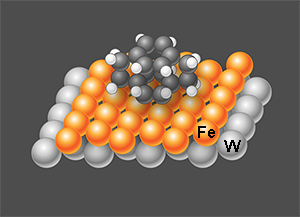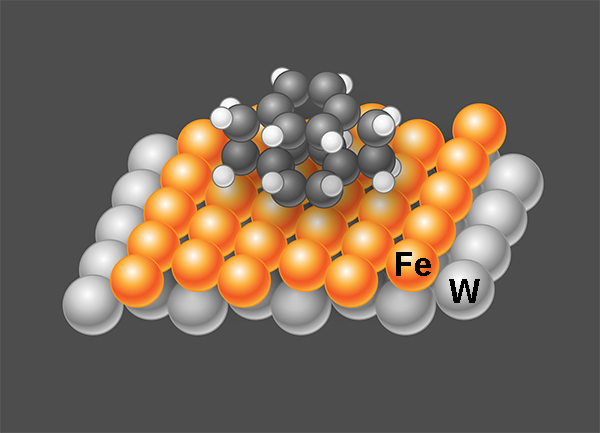Molecules for Spin Devices
Molecular electronics [1] aims to use molecules as building blocks for the fabrication of electronic components—diodes, switches, transistors, and the like. At the heart of this idea is the possibility of synthesizing organic molecules with tailored properties, manipulating their electronic structure and optimizing their binding to different surfaces. Devices as small as a few molecules might lead to substantial size reduction in electronics, providing a possible solution for extending Moore’s law beyond the anticipated limits of conventional integrated circuits [2]. Molecular electronics may also be inspired by developments in modern solid-state spintronics: instead of using the electron charge for manipulating and storing information, one might find it a natural extension to focus on the spin degree of freedom as the ultimate carrier of information. In what has been dubbed “molecular spintronics” [3], the seemingly distinct fields of molecular electronics and spintronics come together. Now, in an article in Physical Review Letters, Martin Callsen and colleagues from the Forschungszentrum Jülich in Germany present theoretical simulations that suggest a new approach for designing molecular spintronics devices [4]. The theorized devices would be suitable to build molecular memory units or spin filters—devices that preferentially transmit electrons with a certain spin orientation.
The idea of manipulating the electron’s spin degree of freedom has long been sought as an alternative to present-day electronics. The greatest success of this endeavor has been the discovery of giant magnetoresistance (GMR) in the late 1980s [5]. The prototypical GMR device is the spin valve, in which a nonmagnetic material is sandwiched between two magnetic ones. In this configuration, a spin-filtering action is observed for different relative configurations of the magnetic moments in the different layers. Switching between two possible magnetization states (parallel or antiparallel magnetization direction of the two layers) results in a significant change in resistance. This effect, now the basis of read heads in computer hard drives, has revolutionized magnetic storage technology
But in order to maintain the trend toward further downscaling, new materials as well as new architectures are necessary. Can a molecular equivalent of a thin-film spin-valve GMR device be envisioned? The key issue of separating the different spin states could be addressed in two ways. The first option would be to use an intrinsically magnetic molecule [6], sandwiched between metallic surfaces. In the same way that the magnetized layers of a spin valve scatter an electrical current differently depending on the polarization of its spins, such a magnetic molecule has a resistance that depends on the spin of an electron passing through it. But in this case, control over the different spin states of the molecule is complicated: the difference in energy between them is typically small, and fluctuations due to temperature might lead to loss of spin polarization. The second option, which is the one explored by Callsen et al., would be to use a nonmagnetic organic molecule and externally induce a spin imbalance in the molecule by binding it to a magnetic surface [7]. By attaching a second surface, or the tip of a small probe, on the other side of the molecule one could achieve, in principle, a spin-filtering effect. In the latter case, long-term stability of the device and reproducibility of its behavior are usually achieved by binding aromatic molecules on surfaces through chemisorption (a chemical process by which new chemical bonds are formed between the molecule and the surface) [7]. A key issue is that, at the interface between molecule and surface, hybrid electronic states are formed whose width in energy is typically broad. This means that, even though there might be some spin imbalance, the induced spin polarization is usually small, and, consequently, neither very efficient for spin filtering nor for magnetic storage.
The design of a suitable molecule-surface complex is thus a complicated task. The search is directed at finding molecules that strongly and stably bind to a surface, while having a large splitting of their spin-dependent energy levels. This is where the contribution of Callsen et al. comes in. The authors chose a nonmagnetic molecule called 2,2-paracyclophan (PCP). It is a stacked aromatic molecule, with a double-decker structure of delocalized π electrons. The two layers are covalently bound at the edges, but the aromatic rings also interact through π stacking, forming a three-dimensional π-conjugated network (see Fig. 1). The authors performed a series of ab initio density-functional calculations, studying the properties of these molecules adsorbed on a magnetic iron (Fe) thin film deposited on top of a W(110) surface.
The authors’ calculations predict several features of the molecule-surface complex that would make it interesting for spintronic applications. They found that the molecule chemisorbs onto the iron surface, leading to a strongly bound and stable structure—an important feature in view of scaling up and assembling these units into integrated circuits. Second, the configuration leads to an induced magnetization of the molecule. This happens because the bonds arise from the strong hybridization of the molecular orbitals with those of the iron surface—the molecule borrows the magnetic nature of the surface to which it is bound. That is not unexpected, however, the predicted hybridization is confined to the lowermost ring. This has an important consequence: the interaction between the two stacked halves of the molecule is not strong enough to broaden the quantized energy levels of the topmost ring, therefore such levels retain most of their molecular character and are thus narrow. At the same time, the interaction is sufficient to induce a highly localized spin-polarized state on the upper segment of the molecule. Thus, charge injected from the surface would be scattered in different ways for each spin channel. From the perspective of a spin filter, one can envision an arrangement whereby a STM tip placed on top of the molecule can be used to probe different currents with nearly perfect spin polarization.
Finally, the authors found what they called a magnetic hardening effect: the magnetic (exchange) interaction between iron atoms immediately below the PCP molecule is much stronger (by a factor of 3) than that between iron atoms at a clean surface. This means that there are two distinct magnetic structures. The first one consists of the original Fe thin film, which could be considered a “soft” magnet, i.e., a magnet that is easy to flip. The second one—a “hard” magnet—is made up of the originally nonmagnetic molecule and the iron atoms immediately below it. The magnetic moment of the latter arrangement, which comes mostly from the iron atoms, can only be flipped by a larger field than that necessary to switch the remainder of the surface. This means that this arrangement could be considered a small, independent magnetic unit. By assembling a number of such units on a surface one can envision a new family of nanoscale storage devices.
References
- M. Ratner, “A Brief History Of Molecular Electronics,” Nature Nanotech. 8, 378 (2013)
- S. E. Thompson and S. Parthasarathy, “Moore’s Law: The future of Si Microelectronics,” Mater. Today 9, 20 (2006)
- S. Sanvito, “Organic Spintronics: Filtering Spins with Molecules,” Nature Mater. 10, 484 (2011)
- M. Callsen, V. Caciuc, N. Kiselev, N. Atodiresei, and S. Blügel, “Magnetic Hardening Induced by Nonmagnetic Organic Molecules,” Phys. Rev. Lett. 111, 106805 (2013)
- M. N. Baibich J. M. Broto, A. Fert, F. Nguyen Van Dau, F. Petroff, P. Etienne, G. Creuzet, A. Friederich, and J. Chazelas, “Giant Magnetoresistance of (001)Fe/(001)Cr Magnetic Superlattices,” Phys. Rev. Lett. 61, 2472 (1988); G. Binasch, P. Grünberg, F. Saurenbach, and W. Zinn, “Enhanced Magnetoresistance in Layered Magnetic Structures with Antiferromagnetic Interlayer Exchange,” Phys. Rev. B. 39, 4828 (1989)
- L. Thomas, F. Lionti, R. Ballou, D. Gatteschi, R. Sessoli, and B. Barbara, “Macroscopic Quantum Tunneling of Magnetization in a Single Crystal of Nanomagnets,” Nature 383, 145 (1996); G.-H. Kim and T.-S. Kim, “Electronic Transport in Single-Molecule Magnets on Metallic Surfaces,” Phys. Rev. Lett. 92, 137203 (2004); N. Baadji and S. Sanvito, “Giant Resistance Change across the Phase Transition in Spin-Crossover Molecules,” 108, 217201 (2012)
- N. Atodiresei, J. Brede, P. Lazić, V. Caciuc, G. Hoffmann, R. Wiesendanger, and S. Blügel, “Design of the Local Spin Polarization at the Organic-Ferromagnetic Interface,” Phys. Rev. Lett. 105, 66601 (2010)





